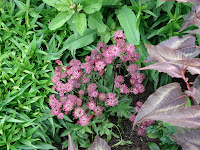 I wanted to share some more photos and thoughts on Heucheras. The above picture is a newer hybrid called 'Citronella'. It's similar to the hybrid 'Lime Rickey' (which has been around for a few years) but I find that the leaves are larger and a paler chartreuse, more of a lemon-lime sorbet colour. Citronella as well as Lime Rickey are shade Heucheras not tolerating any hot afternoon sun. They work very well in a location under a open canopy. Planted in amongst dark green foliage and strong contrasting saturated coloured flowers shows off their unique shade.
I wanted to share some more photos and thoughts on Heucheras. The above picture is a newer hybrid called 'Citronella'. It's similar to the hybrid 'Lime Rickey' (which has been around for a few years) but I find that the leaves are larger and a paler chartreuse, more of a lemon-lime sorbet colour. Citronella as well as Lime Rickey are shade Heucheras not tolerating any hot afternoon sun. They work very well in a location under a open canopy. Planted in amongst dark green foliage and strong contrasting saturated coloured flowers shows off their unique shade. 
Rosewood, Cinnabar, and Peach best describe the tones in my current favourite Huechera 'Peach Flambe'.
It can take more sun than 'Citronella' and performs best in a morning sun / afternoon shade location. Both Huecheras should be hardy with adequate mulching and I find cleaning up and replanting every so many year keeps Heucheras vigorous. 'Peach Flambe' is an unusual colour and has to be located carefully. It works well with other shade plants that have a gray tone ( like Hostas), and any peach or apricot coloured flower. Even red-violet, plum and burgundy coloured foliage and flowers complement this plant. With all the different Heucharas in the garden, I find they are not bothered by any disease or pests (even slugs and snails). As with many plants of their stature occasion light fertilization of any basic organic fertilizer or fish emulsion works great. In winter 'Peach flambe' foliage turns to plum, adding an extra quality to this plant.
Sound pretty delicious to me!














